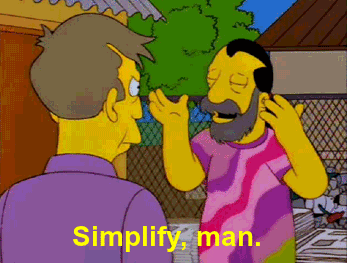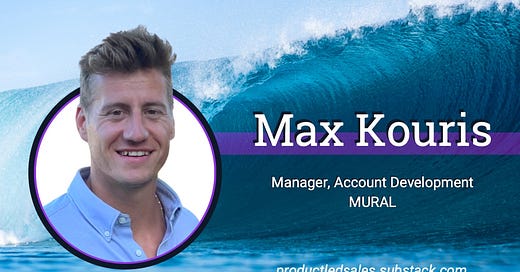Bringing a Curiosity Mindset to the PLG Sales Motion | By Max Kouris, SDR Leader at MURAL
How Max walks in prospects’ shoes and why you should solve for X before Y and Z.
Welcome to all the new Product-Led Sales 🌊 members who have joined us since our last post! Join the smart, curious folks by subscribing here:
Hey y’all!
We launched the Product-Led Sales newsletter with the goal of showcasing the best salespeople and sales leaders at PLS companies.
Our last episode featured product-led sales expert Ryan Patterson, Regional Director, Strategic Sales at Airtable. If you missed it, check it out here: PQLs + PQAs, Elegantly Going Around End-Users to the Decision-maker, & the Blending of a Bottom-up and Top-down Motion.
In this episode, I was stoked to chat with Max Kouris, who is making waves at MURAL. If you’re not yet familiar, MURAL makes virtual innovation seamless. Teams can brainstorm in real-time or asynchronously on a digital whiteboard collaboration space that links up to 300+ templates.
It’s a G2 fan favorite for a reason. When IBM partnered with MURAL, they reached 495% ROI in less than six months. Yeah. They’re kind of a big deal.

Max makes the magic happen by overseeing a team of 12 Account Development Representatives (ADRs), from Georgia to Colorado to Ireland to Australia, in the enterprise space. (We’re talking prospects with 5,000+ employees, here!)
His depth of experience at MURAL is preceded by time at Salesforce, Vertafore and Alchemer.
With rich insight, Max shares:
The importance of a curiosity mindset
How he gets into prospects’ shoes
A Salt Lake City company that cemented his sales approach
How every conversation represents a new opportunity to learn
Perfecting the sales motion with a pod model
Why the first 24 hours after signup are critical
Solving for X, then moving to Y and Z
How enablement can empower your sales team
His thoughts on PLG vs. top-down sales
Take it away, Max.
The importance of getting (and staying) curious
As a sales leader at a rapidly growing product-led growth (PLG) organization, you have to have one thing to succeed and innovate: a curiosity mindset.
Whether you’re talking to the end-user or packaging up insights for an executive—really at any stage in the game—curiosity is your greatest asset.
Never underestimate the power of asking your prospects, “What brought you to us?” Get to know their needs. Their intent. Their path with your product. Then enable them as best you can. Provide guidance and value along the way.
At MURAL, I nurture my curiosity mindset by slowing down to speed up. I do my homework. This usually means simplify, simplify, simplify what the industry can make complex.

I start by putting myself in my prospect’s shoes. At my last company, I began signing up for both direct competitor and non-competitor products from strong PLG operations. I continue this valuable process in my work at MURAL.
Through this research, I can experience products as a prospect would:
What does a cadence look like?
What about the messaging?
How does the sales team approach me?
What research are they doing?
Are they just trying to sell me, or do they actually understand why I’m here?
That last question is the most vital. I gather customer insights during this process and continuously enable my sales team. We must always understand our prospect at the most nuanced level. Never make them feel like they’re just a sale in a list.
How a Salt Lake City Company cemented my sales approach
When I started selling at Salesforce, product name recognition got me an introduction to a number of prospects. But folks outside the tech industry usually needed a proof of concept (POC): a clear example of the product’s value.
Though it was a top-down sales organization, I often found myself talking to reps. One of my prospects, a company out in Salt Lake City, showed me why this was so important.
For two months, I connected with three of their Account Executives (AEs). I learned every single issue about their experience: how reporting came together, how their processes worked, and how a few integrations didn't connect.
First, I gathered strong insights from the bottom up. Then, when I finally got the introduction to their VP, I had a good story to tell.
When I came to MURAL, I imparted this experience to my sales team: you have to be able to talk to everyone from the bottom up in a product-led motion. It’s the only way you’ll truly understand what’s going on for that account.
We need to discover how a prospect uses our product. This gives us a good advantage of understanding how to make the experience relevant. What their journey looks like, from signup to the present moment. Who to talk to next.
At MURAL, we check out member details for our end users constantly. We have a relatively small subset book of business per ADR. So when we see a lot of inbound activity, we zoom in and note any buzzwords we’ve set up to gauge user intent.
These insights translate to our email subject lines, catching attention and sparking the conversation. (For example: our ADRs can send a link within our What’s New With MURAL blog series, which teaches users about new integrations related to those buzzwords.)
Using collaborative curiosity to solve for X before moving on to Y and Z
It’s my mission to perfect our product-led sales motion. We currently pair Sales Development Representatives (SDRs) and AEs together for the entire user journey. While SDRs live in the nitty-gritty details and AEs focus on opportunities, the collaborative power is huge. They’re CC’d together on every email. They meet weekly. They’re constantly building out strategies.
With that being said, we’re still trying to find the balance around how AEs and Account Managers (AMs) play together. Likewise, how do we bring in the Customer Success Manager (CSM) team to help AEs with enablement and activation rate?

The pod model seems to be the answer, with an intentional combination of SDRs, AEs and CSMs per account. This means we need to equip our SDRs in getting a bit more technical with conversations—especially around personas—since they’re the ones getting to that prospect first.
We’re big on a land-and-expand motion. When we get one conversation going with a prospect, it’s pretty easy to start looping in more with different teams. We'll still have our top 10 prospect accounts that we're trying to break into, but expansion is always the goal.
We leverage a Demandbase journey called Marketing Qualified Accounts (MQA) at MURAL. MQAs are accounts with a high engagement score or predictors to become a strong pipeline opportunity. We want to get all of our MQAs into the opportunity stage.
Let’s say we walk into the month with three brand-new accounts. One is already in the opportunity stage, so we try to get two more. Or three opportunities based on the personas we do well in. It’s a constant cycle.
We move prospects to the opportunity phase fast. If a prospect signs up for MURAL and doesn’t figure out how to use it in the first 24 hours—or even one hour—activation rate drops. So, how can we get in front of that prospect as soon as possible?
We keep these processes in place knowing the customer always wants to solve for X. It’s what brought them inbound, after all. We need to help them solve for X before we can move to Y and Z. It’s taking time to figure out their pain and how the product can make it better.
Bringing it all together: Why PLG > top-down sales
If you’re a PLG organization with a top-down sales mindset, you’re going to have a bad time.
When you target the decision-maker above all else, you'll lose a lot of opportunities and miss out on valuable conversations going forward.
Between our teams of SDRs and AEs, everything is focused on the PLG mindset. But we also understand the power of enablement: working together toward our common goal and sharing the knowledge and skills to succeed.
This way, both our product and our sales team are focused on empowering our users.
(Side note: we’re so fortunate to have a fantastic enablement team at MURAL. Everything we train on or roll out sales-wise is centered around PLG.)
The one big difference I’ve found between PLG and top-down sales organizations is playing the long game vs. recycling the same plays.
Here’s how to frame this up. I look at a freemium user in three distinct phases for PLG companies, broken into two-week sprints for each phase:
Enablement – This phase is all about trying to help them solve for X. What brought them inbound? It’s tangentially related to sales, but it’s more marketing.
Relevance – Here we get a bit more salesy. We talk about product relevance per their member activities and details. How many MURALS have they created? How many stickies are they using? Which templates have they integrated?
Movement – If the first two phases don’t convert, we then work our way into different parts of the company. We start a conversation with multiple teams to gain the insights we need.
In a top-down sales motion, you try to make the VP your prospect. But with PLG, you treat both end-users and decision-makers as integral to the process.
You get to know every single buyer's journey—and you need to have a unique strategy for communicating with each stakeholder. Someone signing up for a demo request is totally different than someone who shares their MURAL with a teammate.
With a PLG mindset, each sales conversation isn’t just an opportunity to drive revenue—it’s an opportunity to put your curiosity to work and learn more about both your product and your prospects.
We try to walk this walk at MURAL every day.
If you’re looking for your next sales opportunity, I grow ADRs up through the ranks to SDR leadership, AMs and AEs. Let’s chat.
ICYMI → Product-Led Sales Goodies:
Bottom-up sales vs “normal” sales 3 former Dropboxers talk for 30 minutes about how sales has evolved over the years, as PLG has become more prevalent
This week, the OG, Wes Bush, released his book, Product-Led, for free on ProductHunt. Go get it!
Sonar’s shOPS Talk lining up the hot takes on where RevOps is just Sales Ops rebranded (it’s worth the listen) 👇
Introducing enterprise sales to a product-led growth organization (h/t Sam Arnold for sending my way).
Layering on enterprise sales to a bottoms-up motion can be a breakthrough, or it can be a dangerous pitfall if not implemented well—these six lessons are proven best practices to launch an enterprise go-to-market engine in a PLG company.
Jason Lemkin, bringing some fire metrics (as always) with his latest blog post series: 5 More Top PLG Learnings (h/t to Lars and Nate for sending to me).
What the TL;DR? Don’t worry, here’s the bite-sized version in a Linkedin post.
Last, but not least, more broad topics (they touch on PLG), but overall a killer podcast on the modern GTM teams and how they can be built the right way:
Go follow Max on LinkedIn (you won’t regret it, I promise). And if you enjoyed this post, please forward it along to a few folks and post it on social media (tag me, Brendan)—I appreciate your support! 💜
Thanks for reading and we’ll see you next time!
-Brendan



